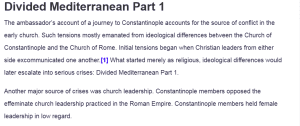Divided Mediterranean Part 1
The ambassador’s account of a journey to Constantinople accounts for the source of conflict in the early church. Such tensions mostly emanated from ideological differences between the Church of Constantinople and the Church of Rome. Initial tensions began when Christian leaders from either side excommunicated one another.[1] What started merely as religious, ideological differences would later escalate into serious crises: Divided Mediterranean Part 1.
Another major source of crises was church leadership. Constantinople members opposed the effeminate church leadership practiced in the Roman Empire. Constantinople members held female leadership in low regard.
At some point, a Constantinople faction member referred to the Roman Empire church leaders as harlots. He claims that he will never accept to be led by harlots.[2] The misalignment of theological principles led to serious crises in the early church.
Further, the early church and its leadership are accused of tyranny. In particular, Adalbert is accused of leading multiple tyrannical practices across the Roman Church. One particular accusation labeled against Adalbert is that he led a reign of terror across the Roman Empire.
Among other things, he is accused of robbing churches of the holy apostles. [3] Despite these obvious evils, none in the Roman Catholic Church responded to try and stop the tyrant’s wayward ways.
However, the historical tensions would later culminate into serious conflicts between the parties that were merely rivals. In one crusade, Christians from the Roman Empire were diverted to attack and capture Constantinople.[4] The confrontation led to significant destruction of churches and religious icons, resulting in the tragic deaths of multiple Christians.
This violence not only inflicted deep emotional wounds on the community but also escalated the traditional hostilities between rival churches, further entrenching divisions and animosities that have persisted over time. The aftermath of this conflict highlights the urgent need for dialogue and reconciliation among different religious groups to restore peace and understanding within the community. Christians, and escalated the traditional hostility between rival churches.
Bibliography
sourcebooks.fordham.edu. “Internet History Sourcebooks Project,” n.d. https://sourcebooks.fordham.edu/source/liudprand-embassy-excerpts.asp.
[1] sourcebooks.fordham.edu. “Internet History Sourcebooks Project,” n.d. https://sourcebooks.fordham.edu/source/liudprand-embassy-excerpts.asp.
[2] sourcebooks.fordham.edu
[3] Ibid
[4] Ibid
ORDER A PLAGIARISM-FREE PAPER HERE
We’ll write everything from scratch
Question 
Your first assignment this week requires you to read the ambassador’s account of a journey to Constantinople and connect it to later events. How does this account reflect tensions within the Christian world, and how does it foreshadow conflicts that would erupt during the Christian Crusades?
To fully answer this question, you will need to do some sleuthing about the characters in this document, why there is tension between them and their countries, and what that tension would eventually lead to. The lectures and textbook can help you to answer all of these questions.
Please cite the readings whenever you quote or paraphrase.

Divided Mediterranean Part 1
- ONLY oUSE THE LINK THAT IS PROVIDED PLEASE